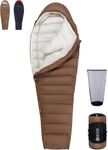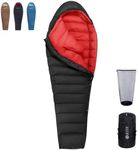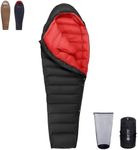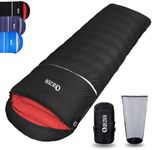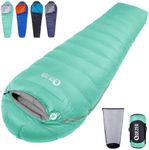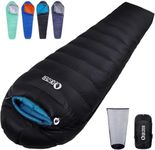Buying Guide for the Best Down Sleeping Bags
Choosing the right down sleeping bag is crucial for ensuring a comfortable and warm night's sleep during your outdoor adventures. Down sleeping bags are known for their excellent insulation properties, lightweight nature, and compressibility, making them a popular choice among campers and hikers. When selecting a down sleeping bag, consider factors such as temperature rating, fill power, weight, and size to find the best fit for your needs. Understanding these key specifications will help you make an informed decision and ensure you stay cozy in various weather conditions.Temperature RatingThe temperature rating of a sleeping bag indicates the lowest temperature at which the bag will keep you warm. This is important because it helps you choose a bag suitable for the conditions you expect to encounter. Temperature ratings are usually divided into three categories: summer, three-season, and winter. Summer bags are suitable for temperatures above 35°F (2°C), three-season bags are ideal for 10°F to 35°F (-12°C to 2°C), and winter bags are designed for temperatures below 10°F (-12°C). Consider the typical weather conditions of your camping trips to select a bag with an appropriate temperature rating.
Fill PowerFill power measures the quality and loft of the down insulation in a sleeping bag. It is expressed as a number, such as 600, 700, or 800, which indicates how many cubic inches one ounce of down can fill. Higher fill power means better insulation and warmth-to-weight ratio. Bags with fill power of 600-700 are considered good quality, while 800 and above are premium. If you need a lightweight bag with excellent warmth, opt for higher fill power. For casual camping, a lower fill power may suffice.
WeightThe weight of a sleeping bag is crucial for backpackers and hikers who need to carry their gear over long distances. Down sleeping bags are generally lighter than synthetic ones, making them a preferred choice for those prioritizing weight. Sleeping bags can range from ultralight (under 2 pounds) to heavier options (over 4 pounds). If you're planning a backpacking trip, aim for a lighter bag to reduce your load. For car camping, weight may be less of a concern, allowing you to choose a heavier bag with more features.
SizeSize refers to the dimensions of the sleeping bag, including length and width. It's important to choose a size that fits your body comfortably without being too tight or too loose. Sleeping bags typically come in regular, long, and extra-long sizes. Regular sizes are suitable for individuals up to 6 feet tall, while long and extra-long sizes accommodate taller individuals. Consider your height and preferred sleeping position when selecting a size to ensure you have enough room to move around comfortably.
Shell MaterialThe shell material of a sleeping bag affects its durability, water resistance, and breathability. Common materials include nylon and polyester, often treated with a durable water repellent (DWR) finish to protect against moisture. A good shell material will keep the down insulation dry and maintain its loft. If you expect wet conditions, prioritize a bag with a water-resistant shell. For dry environments, breathability may be more important to prevent overheating.
